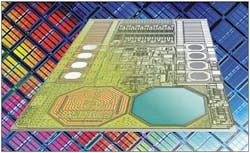Air Force awards nine contracts to build advanced components for electronic warfare
WRIGHT-PATTERSON AFB, Ohio, 1 July 2013. U.S. Air Force researchers awarded nine research contracts Friday for a pivotal initiative similar to the Microwave and Millimeter Wave Monolithic Integrated Circuit (MIMIC) program decades ago to develop some of the world's most advanced and capable electronic and photonic components for tomorrow's electronic warfare (EW) systems.
Officials of the Air Force Research Laboratory Sensors Directorate at Wright-Patterson Air Force Base, Ohio, awarded contracts worth a total of nearly $3 million for the Advanced Components for Electronic Warfare (ACE) Phase 0 program.
Companies receiving contracts for the ACE EW components program are Raytheon Co. in Tewksbury, Mass.; the BAE Systems Electronic Systems segment in Merrimack, N.H.; HRL Laboratories LLC in Malibu, Calif.; Rockwell Collins in Cedar Rapids, Iowa; the Lockheed Martin Space Systems segment in Newtown, Pa.; the Lockheed Martin Corp. Mission Systems and Training (MST) segment in Moorestown, N.J.; the Northrop Grumman Corp. Aerospace segment in Redondo Beach, Calif.; Aurrion LLC in Goleta, Calif.; and LGS Innovations LLC in Florham Park N.J.
ACE Phase 0, like the MIMIC program before it, seeks to establish capabilities, infrastructure, and knowledge necessary to design and produce advanced electronic and photonic components for advanced EW applications at low costs and high yields.
On Friday Raytheon won a $478,324 contract; BAE Systems won $483,554; HRL Laboratories won $234,310; Rockwell Collins won $237,265; Lockheed Martin Space Systems won $248,653; Lockheed Martin MST won $500,000; Northrop Grumman won $242,844; Aurrion won $248,873; and LGS Innovations won $202,584.
The MIMIC program back in the 1980s -- a major microelectronics initiative -- established the capabilities, infrastructure, and knowledge necessary to design and produce gallium arsenide (GaAs) monolithic microwave integrated circuits (MMICs), for nearly any application, with high yields, low costs, and performance and reliability for advanced military and commercial applications.
The ACE Phase 0 contractors will focus on developing integrated photonic circuits (IPC); millimeter-wave source and receiver components for EW (MMW); reconfigurable and adaptive RF electronics (RARE); and heterogeneous integration for photonic sources (HIPS).
Next-generation cognitive and distributed EW systems will require leap-ahead component technologies to keep-up with emerging threats, Air Force researchers say.
For more information contact Raytheon online at www.raytheon.com; BAE Systems Electronic Systems at www.baesystems.com; HRL Laboratories at www.hrl.com; Rockwell Collins at www.rockwellcollins.com; Lockheed Martin Space Systems at www.lockheedmartin.com/us/ssc; Lockheed Martin MST at www.lockheedmartin.com/us/mst; Northrop Grumman at www.northropgrumman.com; Aurrion at www.aurrion.com; LGS Innovations at www.lgsinnovations.com; or the Air Force Research Laboratory Sensors Directorate at www.wpafb.af.mil/afrl/ry.

